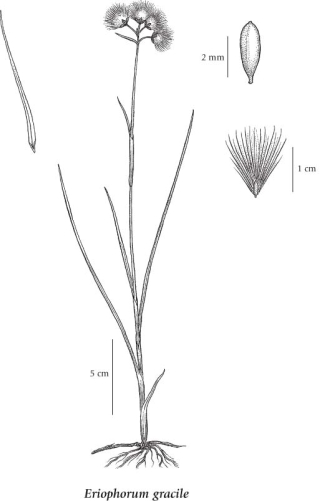slender cotton-grass (slender cottongrass)
Cyperaceae (Sedge family)
Introduction to Vascular Plants
Species Information click to expand contents
General:
Perennial, loosely tufted or turf-forming herb from slender, much-branched rhizomes; stems arising singly, slender, triangular in cross-section, at least above, (15) 20-60 cm tall.
Leaves:
Basal sheaths brownish to reddish-brown, cross-wrinkled, persistent, lacking young basal leaves at flowering time; leaves basal or stem, shorter than the stem, the stem leaves 2 or 3; blades 0.8-1.5 (2) mm wide, elongate, narrow and folded towards the tips or triangular in cross-section, the uppermost leaves with reduced blades usually shorter than the well-developed sheaths.
Flowers:
Spikes 2 to 8, terminal, erect, in compact to open, umbrella-like cymes, the stalks slender, unequal, circular in cross-section, tapered, not evidently compressed, minutely stiff short-hairy, egg-shaped and 0.5-1 cm long in flower, 1.5-2 (2.5) cm long in fruit; anthers mostly 1-3 mm long; involucral bracts several but only one of them evidently green and leaflike, usually shorter than the inflorescence, not purplish basally.
Fruits:
Scales blackish-green to greenish-brown or greyish, egg-shaped to lanceolate, appressed to ascending, the slender midribs not reaching the tips, blunt; perianth bristles numerous, white or whitish, many times longer than the achenes; achenes straw-coloured or light brown, 2.5-3.5 mm long, narrowly egg-shaped to narrowly lanceolate.
Illustration click to expand contents

If more than one illustration is available for a species (e.g., separate illustrations were provided for two subspecies) then links to the separate images will be provided below. Note that individual subspecies or varietal illustrations are not always available.
Illustration Source: The Illustrated Flora of British Columbia
USDA Species Characteristics click to expand contents
Flower Colour:
Yellow
Blooming Period:
Early Summer
Fruit/Seed characteristics:
Colour: Brown
Present from Summer to Fall
Source: The USDA
Ecology click to expand contents
The table below shows the species-specific information calculated from
original data (BEC database) provided by the BC Ministry of Forests and Range.
(Updated August, 2013)
| Site Information |
Value / Class |
||
|
Avg |
Min |
Max |
|
| Elevation
(metres) |
939 | 150 | 1645 |
| Slope
Gradient (%) |
0 | 0 | 16 |
|
Aspect (degrees) |
179 | 55 | 300 |
| Soil
Moisture Regime (SMR) [0 - very xeric; 4 - mesic; 8 - hydric] |
7 | 4 | 8 |
| Modal
Nutrient Regime
Class |
D | ||
| #
of field plots species was recorded in: |
39 | ||
| Modal
BEC Zone Class |
SBS | ||
|
All BEC Zones (# of stations/zone) species was recorded in |
BWBS(1), CWH(3), ESSF(3), ICH(3), MS(3), SBPS(9), SBS(13) | ||
|
Source:
Klinkenberg 2013
|
|||
Habitat and Range click to expand contents
Taxonomic Keys click to expand contents
Key to Eriophorum
1. Spikes 2 or more, subtended by one or more leaflike involucral bracts.
2. Leaves narrow, elongate, folded or triangular in cross-section; involucral bracts solitary, shorter than the inflorescence...........................................E. gracile
3. Spikes crowded, the scales with several conspicuous ribs; perianth bristles orange-brown or coppery...........................................E. virginicum
4. Midribs of scales extending to the tips, sheaths green...............E. viridcarinatum
5. Plants rhizomatous or stoloniferous, usually with solitary stems...............E. scheuchzeri
6. Scales with broad, pale margins, the basal ones reflexed................E. vaginatum
7. Perianth bristles pure white with silky sheen; plants 6-25 cm tall..............E. callitrix Source: Illustrated Flora of British Columbia |